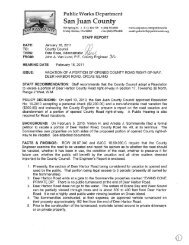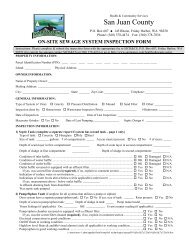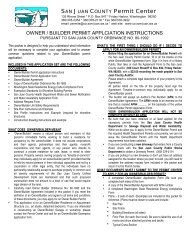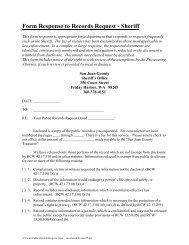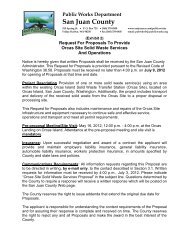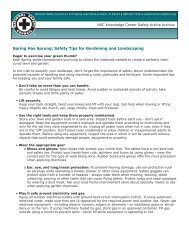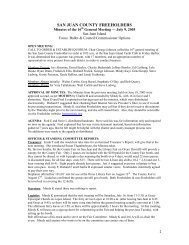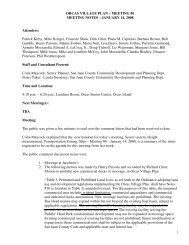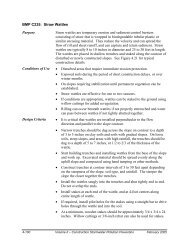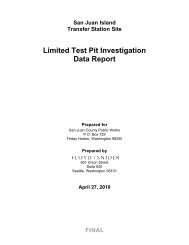Ordinance No._____- 2012 AN ORDINANCE ... - San Juan County
Ordinance No._____- 2012 AN ORDINANCE ... - San Juan County
Ordinance No._____- 2012 AN ORDINANCE ... - San Juan County
You also want an ePaper? Increase the reach of your titles
YUMPU automatically turns print PDFs into web optimized ePapers that Google loves.
Chinook<br />
Chum<br />
Coho<br />
Pink<br />
Sockeye<br />
Steelhead<br />
Rockfish<br />
Boccocio<br />
Canary<br />
Yelloweye<br />
Insects<br />
Great arctic<br />
butterfly<br />
Island Marble<br />
Butterfly<br />
<strong>San</strong>d verbena<br />
moth<br />
Taylor’s Checkerspot<br />
butterfly<br />
Valley silverspot<br />
butterfly<br />
streams. All anadromous (migratory)<br />
populations feed in nearshore areas in<br />
the <strong>San</strong> <strong>Juan</strong>s on their way to the ocean.<br />
Food sources include small fish and<br />
insects, including insects that flow into<br />
nearshore waters from upland streams<br />
and wetlands.<br />
Only recorded US population located on<br />
Orcas Island. Dependent on forest<br />
openings and rocky balds.<br />
Only remaining populations on <strong>San</strong><br />
<strong>Juan</strong> (American Camp) and Lopez<br />
Islands. Dependent on Puget Sound<br />
Peppergrass and other native mustards<br />
and non-native mustards.<br />
Only recorded US populations on <strong>San</strong><br />
<strong>Juan</strong> Island and in Clallam <strong>County</strong>.<br />
Dependent on native sandy coastal<br />
habitat and <strong>San</strong>d Verbena (Abronia) for<br />
larval food plant.<br />
Extremely rare and declining<br />
throughout range. Associated with<br />
maritime prairies and shorelines along<br />
the Strait of <strong>Juan</strong> De Fuca, the postglacial<br />
gravelly outwash and mounded<br />
prairies of the Puget Trough, and open<br />
island prairies with a dominance of<br />
original vegetation. Host plants include<br />
the native seaside plantain (Plantago<br />
maritima macrocarpa) and the<br />
nonnative English plantain (P. major<br />
lanceolata). Concentrations have been<br />
found in SJ <strong>County</strong> on Long Island, and<br />
possibly Lopez Island. Current status<br />
unknown.<br />
Dependent on Western Blue Violet<br />
(Viola adunca). Declining populations<br />
in <strong>San</strong> <strong>Juan</strong> Islands. Extinct in many<br />
Page 51 of 56<br />
Ord. ____-<strong>2012</strong><br />
requirements of this the <strong>San</strong> <strong>Juan</strong> <strong>County</strong><br />
Codesection.<br />
In areas with great arctic butterflies:<br />
●Avoid the use of insecticides and herbicides.<br />
●Protect rocky balds.<br />
In areas with island marble butterflies:<br />
●Avoid the use of insecticides and herbicides.<br />
●Limit grazing and agricultural land<br />
disturbance.<br />
●During land development protect areas with<br />
food sources including Puget Sound peppergrass<br />
and other native and non-native mustards,<br />
In areas with sand verbena moths:<br />
●Avoid the use of insecticides and herbicides.<br />
●Limit grazing and agricultural land<br />
disturbance.<br />
●During land development protect areas with<br />
food sources including <strong>San</strong>d Verbena (Abronia).<br />
In areas with Taylor’s checkerspot butterflies:<br />
●Avoid the use of insecticides and herbicides.<br />
●Limit grazing and agricultural land<br />
disturbance.<br />
●During land development protect areas with<br />
plantain.<br />
In areas with valley silverspot butterflies:<br />
●Avoid the use of insecticides and herbicides.<br />
●Limit grazing and agricultural land<br />
N:\L<strong>AN</strong>D USE\LONG R<strong>AN</strong>GE PROJECTS\PCODES-11-0004 CAO FWHCAs\Docs from PC and CC\FWHCAOrdCC_<strong>2012</strong>-10-26.doc



